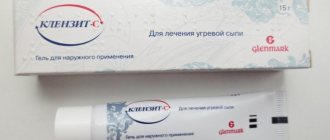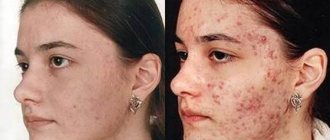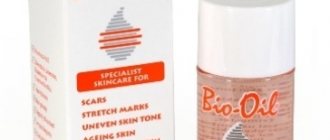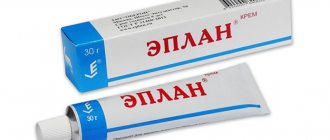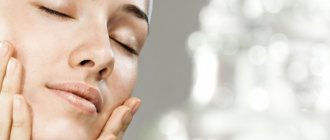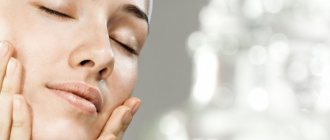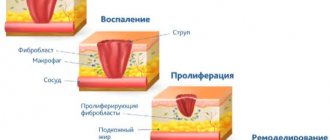Zerkalin is a drug for the treatment of acne vulgaris, the composition penetrates deep into the epidermis and acts specifically on the cause of the skin defect - bacterial activity. Suitable for use in adolescents, it gives a quick effect and does not cause increased sensitivity to ultraviolet radiation.
Review of the drug Zerkalin
Zerkalin is an antimicrobial drug for topical use in dermatology. It is a transparent, colorless liquid substance with a specific odor.
The main drug contains the antibiotic clindamycin. 1 ml of medicine contains 10 mg of the main component. Additional substances are represented by alcohol, purified water and propylene glycol.
You can buy Zerkalin in Moscow in 30 ml tinted glass bottles. Each is equipped with a dropper for dispensing lotion and a cap. The bottles are sold in cardboard boxes complete with annotation.
Composition and release form
Zerkalin is an antibacterial non-hormonal agent for the treatment of acne.
Let's take a closer look at its composition:
Clindamycin (in the form of clindamycin hydrochloride) is a broad-spectrum antibiotic from the lincosamide group, which has a pronounced bacteriostatic effect.
Propylene glycol is a preservative and has an additional antiseptic effect.
Ethanol is an antiseptic and has a disinfectant effect. The substance actively inhibits the growth of all types of bacteria and fungi.
Unlike the gel, Klindovit is a solution and it has a homogeneous liquid structure with a light consistency and a completely transparent color. It comes in 30 ml dark glass bottles with a drip dispenser, which is extremely inconvenient and creates unnecessary difficulties during use.
Drip dispenser
Zerkalin It is necessary to store Zerkalin at room temperature - according to the manufacturer’s advice, no higher than 25 ° C. It is not advisable to store the product in the refrigerator or near heating devices, because If proper storage conditions are not observed, the product deteriorates and loses its effectiveness.
Therapeutic effect of Zerkalin
Zerkalin helps against acne due to the properties of clindamycin. This is a linosamide antibiotic that has a detrimental effect on all strains of propionobacteria that cause acne.
In the process of using Zerkalin the following is noted:
- reducing the number of acne by stopping the growth of pathogenic microflora;
- disappearance of “black spots”;
- smoothing and cleansing of the skin;
- relieving inflammation in the sebaceous hair follicles.
Due to the alcohol content, the medicine is able to penetrate faster into the deeper layers of the skin and act on microbes from the inside. Clindamycin is able to accumulate in pores and act locally in areas of inflammation.
Contraindications
The product has a relatively small number of contraindications, these include:
- Age up to 12 years;
- Hypersensitivity to clindamycin or lincomycin;
- High sensitivity to the components of the drug;
- Taking muscle relaxants;
- Crohn's disease;
- Various colitis.
I would also not recommend the use of Zerkalin during pregnancy, since it can enter the systemic circulation and potentially penetrate the placental barrier, as well as during lactation, since there is insufficient data on this topic in the studies conducted.
How to use Zerkalin
The instructions for Zerkalin prescribe applying the solution only to clean and dry skin twice a day - in the morning and in the evening. For the procedure, you can use a cotton swab or cotton pad.
The duration of therapy is 1.5-2 months. Can be used for up to six months.
If there is no positive dynamics or additional symptoms appear, you need to visit a doctor.
When applying the solution, avoid accidental contact with the mucous membranes of the mouth and eyes, and open wounds. If contact with highly sensitive areas does occur, it is necessary to rinse them in cool water. After the procedure, you must wash your hands well with soap.
Advantages and disadvantages of Zerkalin medicinal liquid
This drug is quite common; there are many reviews about it on the Internet . We have analyzed user ratings and are pleased to present you with a list of the pros and cons of the drug.
Lotion benefits:
- Operational action . After just two days, acne begins to clear up and the skin becomes clearer.
- Normalization of the sebum secretion process . Zerkalin is ideal for people with oily skin types, since the product dries out the epidermis. A person immediately solves two problems: fights acne and increased greasiness of the epidermis.
- 100% action . The drug penetrates deep under the skin, kills bacteria that cause acne. Zerkalin not only eliminates the rash, but also the cause of its appearance.
- Low cost . The drug is in an affordable price range; anyone can afford to buy it.
- Easy to use . There are no difficulties in using the product.
Helpful information
You should not use Zerkalin in parallel with other medications for external use in the treatment of acne, which contain sulfur or salicylic acid, exfoliating ingredients. Since in this case there is an increased irritant effect on the skin.
The lotion is prescribed with caution to persons taking peripherally acting muscle relaxants.
If diarrhea develops during treatment and does not go away for a long time, then the use of the medicine must be discontinued.
The ability to drive a car or engage in other activities requiring increased alertness is not affected.
annotation
Zerkalin is an antibacterial agent that helps to quickly cope with acne.
The drug not only reduces the number of rashes, but also fights the cause of the inflammatory process. Zerkalin contains the antibiotic clindamycin , which fights bacteria that lead to acne.
Thanks to Zerkalin, acne quickly disappears, the skin becomes clean, and the greasiness of the epidermis is reduced several times.
Reviews
The opinions of patients who use Zerkalin in the fight against acne are positive. Within a few days after use, the number of acne noticeably decreases, redness and signs of inflammation disappear, and the appearance of the skin improves.
The absence of side effects, high efficiency and stability of the result are positively noted. However, if acne is severely treated and at an advanced stage, then a local drug will not be enough to solve the problem.
Dermatologists classify the drug as a modern and effective means of treating acne. Prescribed to eliminate rashes on the chest and back. It is recommended to use it with caution on the face due to the presence of ethyl alcohol. In any case, you must follow the instructions and follow the dosage regimen to avoid side effects.
Analogs
If you want something inexpensive, but very effective, then we recommend turning your attention to the following drugs. Zerkalin has the following analogues, which are divided into several groups.
With antibiotic
These creams contain components of similar (or the same) action (one or more), but in different dosages and forms, these include:
- Klenzit – C;
- Klindovit;
- Dalatsin;
- Sintomycin;
- Levosin;
- Levomethyl;
- Levomekol;
- Tetracycline;
- Erythromycin;
- Dioxidine.
| Name | Price |
| Dalatsin | ~900 rubles |
| Klindovit | ~400 rubles |
| Klenzit – C | ~700 rubles |
| Sintomycin | ~100 rubles |
| Levosin | ~100 rubles |
| Levomethyl | ~70 rubles |
| Levomekol | ~150 rubles |
| Tetracycline | ~100 rubles |
| Erythromycin | ~100 rubles |
| Dioxidine | ~450 rubles |
No antibiotic
These ointments and creams have different ingredients, dosages, indications and contraindications, but they have similar pharmaceutical effects.
Non-structural analogues include:
- Liniment Vishnevsky;
- Ichthyol ointment;
- Stellanin;
- Metrogyl gel (Rozamet cream);
- Baneocin.
| Name | Price |
| Liniment Vishnevsky | ~80 rubles |
| Ichthyol ointment | ~80 rubles |
| Stellanin | ~420 rubles |
| Metrogyl gel (Rozamet cream) | ~220 rubles (~450 rubles) |
| Baneocin | ~400 rubles |
Cheaper, more effective and accessible analogues are the following drugs: lincomycin and erythromycin.
Before purchasing an analogue, it is strongly recommended to consult a dermatologist (the analogue may not be suitable for the patient to treat inflammation that he has developed).
Zerkalin solution for external use 10 mg/ml 30 ml No. 1
Name
Mirror.
Description
Colorless transparent liquid with the odor of ethanol.
Main active ingredient
Clindamycin.
Release form
Solution for external use
Dosage
10 mg/ml in vial. 30ml.
Pharmacological properties
Pharmacodynamics
Clindamycin is an antibiotic of the lincosamide group, has a bacteriostatic or bactericidal effect, depending on the concentration at the site of application and the sensitivity of microorganisms. Clindamycin inhibits protein synthesis in the cells of sensitive microorganisms due to interaction with 5OS ribosomal subunits. The spectrum of action of clindamycin in vitro and in vivo includes most gram-positive bacteria, a number of anaerobic pathogens and protozoa. The most common indications for use are anaerobic staphylococcal and streptococcal infections, as well as the prevention of endocarditis. The mechanism of action of clindamycin in the treatment of acne has not been fully studied; it is believed that it is based on the antibacterial activity of the drug. When the drug is applied to the skin, the growth of sensitive microorganisms is suppressed, including strains of Propionibacterium acnes found in the sebaceous glands and follicles, and a decrease in the concentration of free fatty acids (FFA) in sebum is recorded. This effect is due to indirect suppression of the activity of microorganisms that produce lipase, which is necessary for the conversion of triglycerides into FFA, or is a direct consequence of a decrease in the production of lipase by microorganisms. Clindamycin is active against all strains of Propionibacterium acnes, the minimum inhibitory concentration (MIC) is 0.4 μg/ml. After application to the skin, the amount of free fatty acids on the skin surface is reduced from approximately 14 to 2%.
Pharmacokinetics
Clindamycin quickly accumulates in comedones, where it exhibits antibacterial activity. The average concentration of the antibiotic in the contents of comedones after applying the solution significantly exceeds the minimum inhibitory concentration for all strains of Propionibacterium acnes, the causative agent of acne. The bioavailability of clindamycin after application to the skin is about 7.5%. At the same time, very low concentrations of clindamycin are determined in blood plasma and urine.
Indications for use
The drug is used to treat acne (acne vulgaris).
Directions for use and doses
Externally. The solution is applied to the affected area of previously cleansed and dried skin 2 times a day, morning and evening. Course of treatment: to obtain satisfactory results, treatment should be continued for 6-8 weeks, the maximum effectiveness of the drug is observed after 12 weeks of use. Use in children The safety and effectiveness of the drug in children under 12 years of age have not been established, therefore the drug is not prescribed to children in this age category. Use in elderly patients A number of clinical studies have not revealed any peculiarities in the use of the drug in elderly patients compared to younger patients.
Use during pregnancy and lactation
External use of the solution during pregnancy is possible if the expected benefit to the mother outweighs the potential risk to the fetus. If use is necessary during lactation, it is recommended to stop breastfeeding.
Impact on the ability to drive a car and operate other mechanisms
A 1% solution of clindamycin does not affect the ability to drive a car or operate other machinery.
Precautionary measures
Age up to 12 years, lactation period. Use with caution in patients with allergies, as well as when taking muscle relaxants simultaneously. Topical use of clindamycin may lead to the growth of resistant microorganisms (the occurrence of gram-negative folliculitis). If infection occurs during treatment with clindamycin, treatment should be discontinued and appropriate therapy should be instituted. Possible systemic effects of clindamycin may lead to adverse events from the gastrointestinal tract (including pseudomembranous colitis). The patient should stop using clindamycin and consult a doctor if symptoms such as diarrhea occur with topical application of the drug. When using the drug, avoid contact of the drug with the eyes and mouth, and wash your hands after use. Propylene glycol, which is part of the drug Zerkalin, can cause skin irritation. The medicine contains ethanol, which can cause burning and irritation of the eye mucosa. In case of accidental contact with eyes, damaged skin or mucous membranes, rinse thoroughly with cool water. Clindamycin topical solution has an unpleasant taste and should be applied with caution to the mouth area.
Interaction with other drugs
Concomitant use of clindamycin hydrochloride with other acne medications containing exfoliants, emollients, and abrasives (eg, benzoyl peroxide, tretinoin, resorcinol, salicylic acid, sulfur) is not recommended due to the potential for cumulative skin irritation. Clindamycin and erythromycin are antagonists, as a result of which the simultaneous use of these antibiotics is not recommended. There is cross-resistance between clindamycin and lincomycin. Clindamycin may enhance the effect of muscle relaxants by interfering with neuromuscular transmission. In patients treated with clindamycin in combination with vitamin K antagonists (warfarin, acenocoumarol, fluindione), changes in blood clotting parameters were observed (increased PT/INR values). In this regard, patients taking vitamin K antagonist drugs should regularly evaluate the state of the blood coagulation system.
Contraindications
History of hypersensitivity to clindamycin or lincomycin, as well as other components of the drug; history of inflammatory bowel disease or antibiotic-associated colitis.
Compound
100 ml of the drug contains Active ingredient: 1.14 g of clindamycin hydrochloride (corresponds to 1 g of clindamycin) Excipients: ethyl alcohol 96% - 60.80 g; propylene glycol - 8.69 g; purified water - 17.37 g.
Overdose
If excessive topical use occurs, sufficient amounts of clindamycin may be absorbed to produce systemic effects (see Precautions section). In case of overdose, symptomatic treatment is carried out.
Side effect
The drug is usually well tolerated, however, when applied topically, the solution may cause irritation (at the site of application), burning, itching, dry skin, erythema, peeling, increased sebum secretion, and contact dermatitis. Gastrointestinal disorders, abdominal pain, eye irritation, folliculitis, hypersensitivity reactions, and urticaria may occur. With resorption, there is a risk of developing pseudomembranous enterocolitis. Very rarely, neuromuscular blockade may develop. If the listed adverse reactions occur, as well as reactions not listed in the instructions for medical use, you should consult a doctor.
Storage conditions
Store in a place protected from moisture and light, out of reach of children at a temperature not exceeding 25°C.
Buy Zerkalin solution for external use 10 mg/ml 30 ml No. 1 in the pharmacy
Price for Zerkalin solution for external use 10 mg/ml 30 ml No. 1
Instructions for use for Zerkalin solution for external use 10 mg/ml 30 ml No. 1
